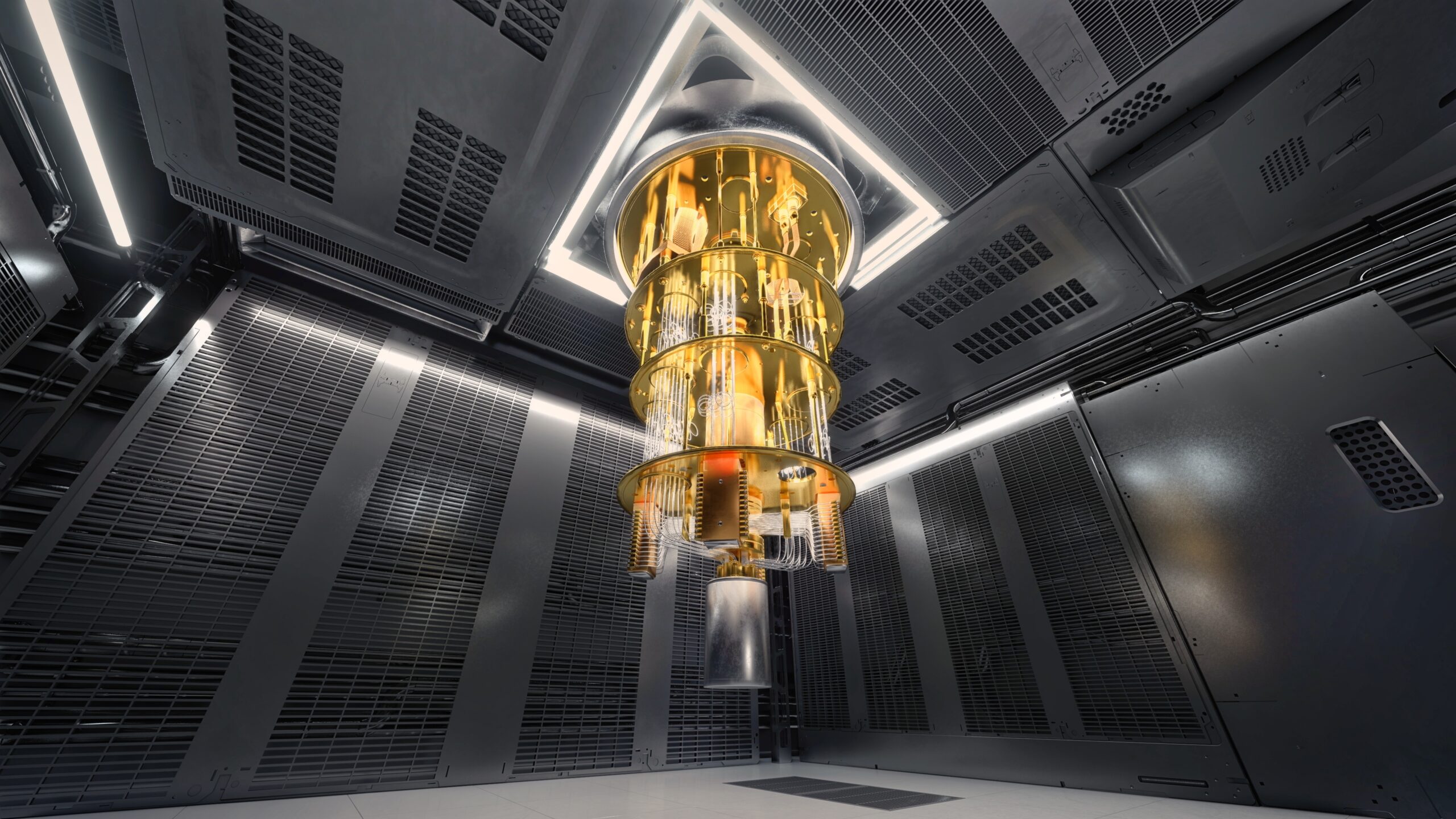10/08/2023
As established in our previous quantum computing blog here, there is undoubtedly still a substantial amount of research and investment required to realise the full potential of quantum computing. At present, researchers have their sights set on achieving so-called ‘quantum supremacy’: the point at which quantum computers can solve a problem that no classical computer could feasibly solve.
However, the persisting problem that has so far prevented the attainment of quantum supremacy has been noise arising from large errors and decoherence rates in quantum processors. The solution to this problem, and the holy grail of quantum computing, is fault-tolerant quantum circuitry. To achieve this is no small feat, and it will likely require a two-pronged approach comprising improved physical qubit stability and error-correcting codes in order to be solved.
Noisy Intermediate Scale Quantum Computers
Whilst fault-tolerant quantum processors are yet to be realised, significant investment has been directed towards developing Noisy Intermediate-Scale Quantum (NISQ) computers. As suggested by their name, these computers are limited by substantial noise (error rates) and are small in scale due to constraints posed by increasing the number of qubits. Consequently, current NISQ computers struggle to outperform classical computers and are generally used to boost performance in specific simulation use cases, see fig. 1.

The problems with NISQ computers are well illustrated by considering DiVincenzo’s five criteria for assessing the suitability of hardware for quantum computation:
- A scalable physical system containing well-defined qubits;
- The ability to deterministically initialize the system into a well-defined initial state (able to input starting information);
- A set of universal quantum gates, such as single-qubit and entangling two-qubit gates (the building blocks of quantum circuits);
- Qubit decoherence are much longer than gate times (making sure the system remains ‘quantum’ whilst operating); and
- The ability to perform measurements on the qubit state with high accuracy (able to get the final information out).
Present NISQ systems can address some but not all these criteria in combination.
Despite their shortcomings, NISQ computers are still useful testing beds for developing quantum software and algorithms (such as Shor’s algorithm for finding prime factors) [1]. From investment trends, it seems apparent that NISQ quantum computers will in fact be a key ingredient for achieving quantum supremacy. For example, the UKRI National Quantum Computing Centre (NQCC) has received £93 million in funding, with their primary technology work stream over the next five years being development of NISQ technology [2].
Glimmers of potential quantum supremacy have been seen in NISQ devices such as Google’s Sycamore processor, see fig. 2. The 54-qubit processor comprised high-fidelity quantum logic gates which solved a sample problem in just 200 seconds, whilst conventional supercomputers would have taken 10,000 years to complete the same problem [3]. A rough comparison of the classically tractable (can be reasonably achieved by a conventional ‘classical’ computer) and the supremacy regimes can be seen in fig. 3. In spite of Google’s demonstration, we are yet to see devices that are demonstrably superior to classical devices outside of very narrow test cases such as this.


NISQ Platforms
Whilst it is currently unclear which platform will be the favoured choice for future quantum computers, there are a few leading contenders being developed with NISQ implementation:
1. Superconducting qubits
To approximate a two-state basis (i.e. 0 or 1 states like in a conventional computer), quantum computers rely on the phenomenon of non-linearity or ‘anharmonicity’. This can be readily achieved using superconducting qubits that take advantage of superconductivity and the Josephson effect. Charge, flux, and phase qubits were the first examples of superconducting qubits, with improvements in fabrication and measurement seeing other examples such as transmon, quantronium, and fluxonium qubits being constructed. The aforementioned Sycamore processor from Google is one of the best-known examples of a superconducting qubit processor, and utilises transmon qubits arranged in a lattice so that each qubit is coupled to 4 neighbouring qubits [4].
2. Photonics
Photonic systems are also a leading candidate for implementation in quantum computers. Typically information is encoded in photons, which introduces an immediate reduction in noise compared to other methods since photons rarely interact with the environment. However, it is also challenging to get individual photons to interact with one another, a requirement for realising quantum gates. Whilst the optimum architecture for a photonic device is yet to be found, quantum computing company Xanadu are working towards a scalable fault-tolerant photonic processor that would function at room temperature, as opposed to superconducting processors which work close to absolute zero [5].
3. Trapped ions
Electromagnetic fields and lasers can be used in combination to restrict the spatial movement of ions, and thus lower their temperature. When fixed, internal states of a trapped ion can be reduced to a two-state basis and each ion is analogous to a qubit. This technique has seen relatively large interest, with companies such as IonQ and Honeywell Quantum Solutions leading the charge.
Applications
Despite the fact that quantum supremacy has not yet been achieved, the variety of implementations for NISQ computers are impressively wide-ranging, not least in the burgeoning area of AI. Quantum computers deal with large sets of data much more comfortably than conventional computers and, combined with their increased computational capacity, will no doubt make future AI tools far more powerful than their contemporary counterparts.
NISQ computers can also be used for quantum simulation allowing for complicated systems to be modelled and outcomes predicted with increased ease. As discussed in a previous insight, quantum simulation can be used for drug research, battery design, and more.
NISQ computers have also been demonstrated as effective numerical solvers, allowing for approximate numerical results to be found to complicated mathematical problems. Whilst seemingly abstract, this has an expansive variety of potential implementations, including weather prediction and spacecraft control.
The future of NISQ computers and beyond
We are not currently at the stage of quantum supremacy. However, it is apparent that a large amount of research is going into developing NISQ computers as means of reaching this goal. The main issues of quantum computing remain scalability and noise, both of which are addressed to varying degrees of success by the current NISQ platforms available.
Whilst there is no doubt that the quantum computing regards NISQ computers as a stepping stone in reaching quantum supremacy, this intermediate step is triggering innovation itself such as NISQ-targeted quantum circuit decompositions for circuit synthesis and error mitigation techniques. There are also already a number of useful applications for current iterations of quantum processors. This will become more apparent as access to quantum processors becomes more commonplace, for example through Amazon’s ‘Braket’ platform. As a result, there are many reasons to be excited about imminent NISQ discoveries as much as the eventual goal of fault-tolerant computing.
Interestingly, recent breakthroughs from IBM with their 127-qubit Eagle-class processor have demonstrated quantum supremacy for the first commercially useful implementation, namely molecular simulation [6]. In light of this, it is perhaps conceivable that quantum supremacy may be achieved in the NISQ era before full fault-tolerant quantum computing is realised.
Here at Reddie & Grose we have a large number of attorneys in our electronics and software team with interest and experience in quantum technologies. If you need help protecting your innovations in this field then please do get in touch.
Sources:
[1] Lau, J.W. et al. (2022) ‘NISQ computing: Where are we and where do we go?’, AAPPS Bulletin, 32(1). doi:10.1007/s43673-022-00058-z.
[2] Strategic intent (2021) UKRI NQCC
[3] Wednesday, O. 23 and Computing, C.S.Aiq. Quantum supremacy using a programmable superconducting processor, Google Research Blog.
[4] Arute, F. et al. (2019) ‘Quantum supremacy using a programmable superconducting processor’, Nature, 574(7779), pp. 505–510. doi:10.1038/s41586-019-1666-5.
[5] Bourassa, J.E. et al. (2021) ‘Blueprint for a scalable photonic fault-tolerant quantum computer’, Quantum, 5, p. 392. doi:10.22331/q-2021-02-04-392.
[6] IBM quantum uses error mitigation to push current quantum computers past classical supercomputers (1AD) Omdia.
This article is for general information only. Its content is not a statement of the law on any subject and does not constitute advice. Please contact Reddie & Grose LLP for advice before taking any action in reliance on it.



